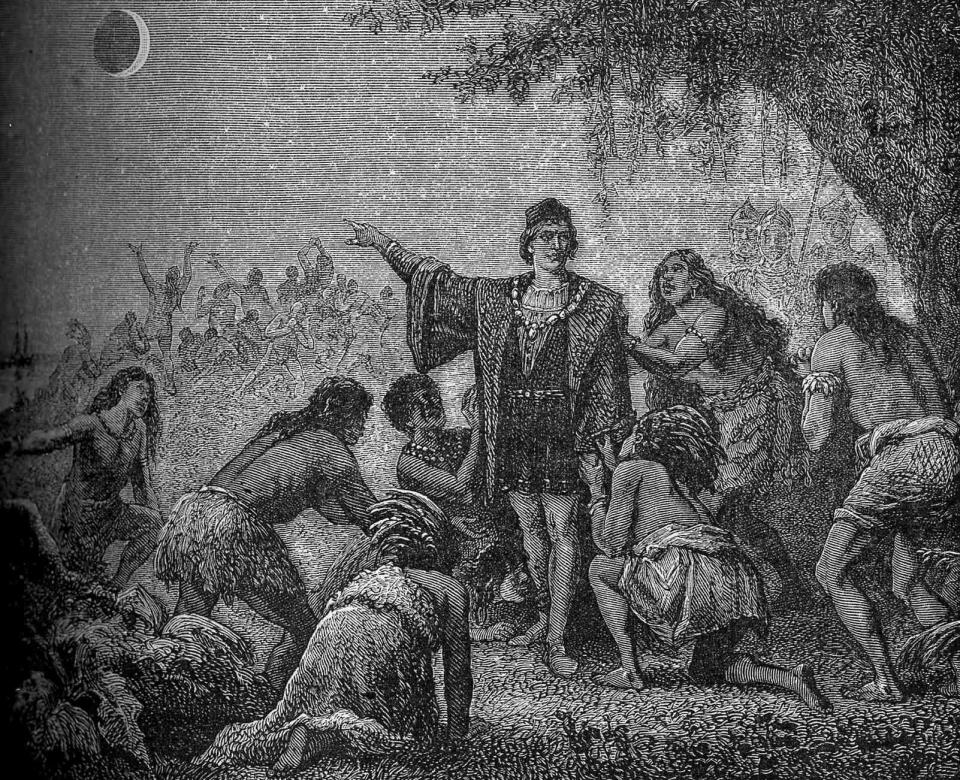How Christopher Columbus used a lunar eclipse to his advantage

Over the next three weeks, this column will look at some fascinating historic — and future — true stories involving eclipses to get everyone intrigued and excited for the solar eclipse coming April 8. Here is our first true story.
Throughout history, eclipses have been pivotal in shaping events, cultures, and scientific understanding. For instance, the ancient Greek historian Herodotus wrote of a solar eclipse that abruptly halted a battle between the Lydians and the Medes, leading to peace talks. That eclipse had a great and positive impact.
And then there are stories that have a happy ending for just some of those involved. In this historical example, Christopher Columbus used his knowledge of a lunar eclipse to manipulate indigenous peoples in the Caribbean. Let’s take a look at what happened.
In 1504, Christopher Columbus and his crew faced a dire situation in Jamaica. Their voyage had come to an unexpected halt as their ships, battered and no longer able to safely float, trapped them far from home.
With their vessels in disrepair and stranded on foreign shores, the situation was becoming increasingly desperate, requiring an ingenious solution to secure their survival and eventual return. They needed food and supplies badly but the local people, who had been friendly at first, were getting tired of helping them. Columbus needed a plan to convince them to help again.

Columbus knew a lot about the stars and the sky. He remembered reading about lunar eclipses, which is when the Earth comes between the sun and the moon, making the moon look dark and sometimes red. An eclipse was going to happen soon, and Columbus had an idea.
He called a meeting with the leaders of the local people. He told them he had a message from his god: because they weren't helping his crew, he would make the moon disappear as a warning. The leaders were unsure, but agreed to watch.
On the night of the eclipse, everyone was watching the sky. Slowly, the moon started to disappear, covered by Earth's shadow, and it turned a spooky shade of red. People were amazed and scared. They thought Columbus really did have the power to take away the moon!
Seeing their fear, Columbus went back to his cabin, pretending to talk to his god. After a while, he came out and announced his god had listened to his pleas. The moon would come back if they promised to help him and his crew. As the Earth's shadow moved away and the moon started to shine again, everyone sighed with relief.
The local people, impressed and a bit scared by Columbus's "power," quickly agreed to give him the supplies he needed. Columbus's trick worked perfectly. He used his knowledge about eclipses to turn a tough situation into a win for his crew.
This story shows how understanding science can sometimes give you a big advantage. Columbus's clever use of the lunar eclipse not only got him the help he needed, but also left a story people would talk about for centuries. It was a mix of smart thinking, a bit of acting, and a lot of help from the moon!
However, recent reflections on history have illuminated that Columbus was not always the heroic explorer once universally celebrated. Accounts and historical evidence suggest his interactions with indigenous people were often cruel.
This incident of using a lunar eclipse to trick the locals into supplying his crew adds another layer to the complex legacy of Columbus, blending scientific knowledge with moral trickery.
Mike Szydlowski is a science teacher and zoo facilitator at Jefferson STEAM School.
TIME FOR A POP QUIZ
What significant event involving an eclipse occurred between the Lydians and the Medes?
How did Christopher Columbus use his knowledge of a lunar eclipse in 1504?
What is the difference between a solar and a lunar eclipse?
How did the local people react to the lunar eclipse manipulated by Columbus?
What lesson can we learn from Columbus' use of the lunar eclipse?
LAST WEEK'S QUIZ ANSWERS
What caused the extinction of woolly mammoths?
Woolly mammoths went extinct due to climate change and hunting by early humans, which reduced their habitats and food sources.
How are scientists working to bring back woolly mammoths?
Scientists are using genetic engineering and special stem cells from the Asian elephant to recreate traits that allowed woolly mammoths to survive in Arctic conditions.
Why is the de-extinction of woolly mammoths significant for elephant conservation?
The techniques developed for mammoth de-extinction could help in creating and fertilizing reproductive cells artificially, offering new methods for conserving endangered elephant species.
What other extinct animals are scientists considering for de-extinction?
Scientists are also exploring the de-extinction of the passenger pigeon, the dodo, and the Tasmanian tiger, among others.
What are the ethical and ecological considerations of de-extinction?
De-extinction raises questions about the habitats and roles of resurrected species in modern ecosystems.
This article originally appeared on Columbia Daily Tribune: How Christopher Columbus used a lunar eclipse to his advantage

